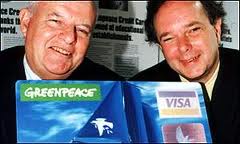 Many mainstream environmental groups have failed to acknowledge the role of consumerism in environmental degradation. Many raise money through shops and sales of ‘green’ consumer goods.
Many mainstream environmental groups have failed to acknowledge the role of consumerism in environmental degradation. Many raise money through shops and sales of ‘green’ consumer goods.
In Australia, the Nature Conservation Council of NSW (NCC), an umbrella group for many of the state’s environmental groups, has formed a support organisation called Ecofriends which enables people to join for a $A55 per year fee. In return members will rece ive information about the NCC’s campaigns, and discounts off various purchases including IMAX cinemas, Harvey Normal stores which sell household appliances “including energy efficient items”, Paddy Pallin camping and outdoor gear, and the Australian Conservation Foundation’s shop.
ive information about the NCC’s campaigns, and discounts off various purchases including IMAX cinemas, Harvey Normal stores which sell household appliances “including energy efficient items”, Paddy Pallin camping and outdoor gear, and the Australian Conservation Foundation’s shop.
 In the US the World Wildlife Fund (WWF) encourages supporters to go shopping as part of its "Shop to Support" program. Also, the Bank of America has a World Wildlife Fund BankAmericard Cash Rewards™ Visa® credit card. Whenever such a credit card account is opened the Bank donates $100 to WWF, and for every $100 in purchases the WWF receives 25c. In this way the more the card holder consumes the more WWF earns.
In the US the World Wildlife Fund (WWF) encourages supporters to go shopping as part of its "Shop to Support" program. Also, the Bank of America has a World Wildlife Fund BankAmericard Cash Rewards™ Visa® credit card. Whenever such a credit card account is opened the Bank donates $100 to WWF, and for every $100 in purchases the WWF receives 25c. In this way the more the card holder consumes the more WWF earns.
According to a WWF brochure, "Your company can use a World Wildlife Fund tie-in to achieve virtually every effort in your market plan... New Product Launches; Corporate Awareness; New Business Contacts; Brand Loyalty."
When green marketing first emerged, it came under criticism from a number of Greenpeace campaigners. Paul Gilding, then head of Greenpeace Australia, described it as a strategy of "Bung a dolphin on the label and we'll be right." Greenpeace Magazine asked rhetorically whether people should buy recycled paper from a company that pollutes rivers with pulp mill effluent.
"It's not that all these ads are untrue," observed Peter Dykstra, then media director of Greenpeace USA. The problem, he said, is that "they depict 5 percent of environmental virtue to mask the 95 percent of environmental vice." Others, such as Dadd and Carothers writing in Greenpeace Magazine, asked whether we should buy recycled paper from a company that polluted rivers with pulp mill effluent.
In 1997 Greenpeace in the UK launched a ‘green’ credit card in conjunction with Co-Operative Bank and Monsanto, whom Greenpeace has traditionally opposed. Monsanto’s product Biopol, enabled Greenpeace to offer an almost PVC-free biodegradable plastic credit card. The launch was accompanied by a national advertising campaign. In a press release, Greenpeace Executive Director, Peter Melchett, said that the card was a “real breakthrough for the environment” because “it will directly reduce the pollution caused by the manufacture and disposal of PVC.”
 The Greenpeace Visa card features the Greenpeace name and pictures one of its ships on the front. Greenpeace receives £10 for each new account opened and 25p for every £100 spent using the card amounting to an estimated £200,000 per year. The credit card has lower interest charges than normal so the consumer does not have to make any sacrifices in choosing to use the Greenpeace Visa card.
The Greenpeace Visa card features the Greenpeace name and pictures one of its ships on the front. Greenpeace receives £10 for each new account opened and 25p for every £100 spent using the card amounting to an estimated £200,000 per year. The credit card has lower interest charges than normal so the consumer does not have to make any sacrifices in choosing to use the Greenpeace Visa card.
In this way Greenpeace benefits directly from consumerism—the more purchases that people make using their credit cards, the more money is donated to Greenpeace. And the bank gains from additional customers and increased use of their credit cards.
Greenpeace also played a vital role in the marketing of the 2000 Olympics to be held in Sydney. They not only allowed the organisers to 'bung a dolphin on the label' but they have helped them to market the environmental virtues of the games while ignoring some key environmental vices. In particular, as described here, Greenpeace helped sell the concept of the Green Olympics to the IOC without alerting it to the extent of the toxic waste problem.
As early as 1994 Greenpeace Australia CEO Paul Gilding noted that, “As a trademark, Greenpeace is right up there with Levis and Coca-Cola.” And from at least 1995 Greenpeace has been licensing its name to private firms which produce Greenpeace calendars, greeting cards and other miscellaneous items. The Economist reported that an American firm of management consultants estimated that the “worldwide value of the Greenpeace brand” was around $410 million in 1998. It noted: “Stamped on various eco-friendly products, it could lend a cachet that might become de rigueur in trendy green circles.”
The Nature Conservancy (TNC) raises funds by licensing its name to consumer products such as a granola bar and brands of coffee. It allows its name and logo to be used in return for substantial payments by corporations wishing to green their image through the association.
In the 1990s MCI donated 5 percent of the bills paid by people who switch to their telephone service to four major conservation groups including TNC, a deal worth some $400,000 annually.
The Conservancy also allowed S.C. Johnson & Sons Inc. to use the Conservancy logo in ads for toilet cleaner and other products, receiving $100,000 in return. The corporation's chairman sat on the nonprofit's board.
Although buyers might assume the logo indicates the toilet cleaner is more environmentally friendly this is not the case. There is no TNC endorsement of the product implied by the use of the logo, merely a cash transaction.
The Conservancy has rented its name and logo for use on neckties, breakfast cereal, coffee and credit cards. Companies pay six-figure fees to stamp the Conservancy's oak leaf on their packaging. Conservancy vice president Michael Coda, who developed the program, describes logo sales as a "very good deal" for the nonprofit.
TNC even marketed “Conservation Beef” with the message to consumers that their “purchase will help save the great Western landscapes for future generations”. Ranchers who raised the beef for this program had development restrictions on their grazing land and followed ‘stewardship plans’ that they put together themselves based on guidelines provided by TNC. The Madison Valley Ranchlands group, made up of Montana ranchers, monitored the program.
However, Consumers Union, which publishers Consumer Reports magazine, said the program has a conflict of interest "since [Conservation Beef] helps create the guidelines and [Conservation Beef] benefits from the sale of the product."
CU's Urvashi Rangan said, "The ranchers pretty much can do whatever they want. They have very loose guidelines."